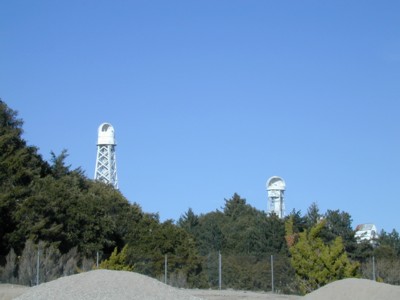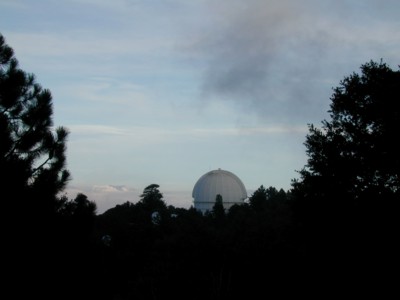The Story of Mt. Wilson, California
Part 2--1889 to 1940
Benjamin's Mountain
By Marvin Collins
The installation of the Harvard telescope, along with the problems encountered in transporting the instrument up the old trail, caused a renewal of interest in a Mt. Wilson road. In June 1889, Judge Benjamin Eaton called a meeting of prominent Pasadena businessmen to consider building a wagon road to Mt. Wilson. Eighteen of the businessmen agreed to contribute capital and on July 12, 1889 "The Pasadena and Mount Wilson Toll Road Company" was incorporated. Nothing substantial was accomplished before the company floundered in financial difficulties.
Five of the original eighteen investors reorganized and refinanced the project. They decided it would be feasible to build a four foot trail starting at Eaton Canyon rather than the twelve foot roadway originally proposed now that the Harvard telescope had been removed and public interest in Mt. Wilson had dwindled. In February of 1891 work commenced and by June the ten mile pathway was in usable shape. In July the new trail was officially opened to the public and the toll fixed by the Board of Supervisors at 25 cents for hikers and 50 cents for riders. This new well graded pathway became known as the "New Mt. Wilson Trail" and it soon became more popular than the "Old Mt. Wilson Trail" from Sierra Madre. Foot and pack animal traffic became so heavy that in June of 1893 it was decided to widen the trail to six feet. This made two way travel easier.
Gradually the Mt. Wilson Toll Road Company acquired control of the mountain. In 1896 the company acquired both Strain's and Martin's camps. In 1901 the company paid the United States Land Office $800 for clear title to 640 acres on the mountain top. In 1904 The Mount Wilson Toll Road Company enlarged its holdings to 1050 acres and became "king of the mountain." In 1905 the company entered into a 99 year lease with the Carnegie Institution granting 40 acres of the mountain top for the location of the Carnegie Institution observatory. The new observatory was also given free use of the toll trail and half the water rights on the mountain. In return, the Carnegie Institution agreed that the public would always have access to the observatory.

|
Two solar telescopes at Mt. Wilson Observatory.
|
The Carnegie Observatory renewed interest in Mt. Wilson and brought many visitors to the mountain top. To accommodate the many visitors the toll road company in 1905 constructed a one story hotel. Many cottages were constructed around the main building for the use of overnight guests. Fire destroyed this first hotel in 1913. Two years later a larger hotel was completed on the same site. It even included a spacious swimming pool. This second hotel was managed for years by A. C. Childs, the son in law of one of the investors in the toll road company.
As new, larger telescopes were designed for the Carnegie Observatory, an auto road to the summit of Mt. Wilson became an absolute necessity. In 1907, to transport the larger and heavier parts of the 60 inch reflector telescope, the trail was finally widened into a ten foot roadway. The work was done mostly by hand, mainly by Japanese labor, with mule drawn scrapers and plows to move the dirt and rock. In 1917 the road was widened to its final width of 12 feet to accommodate the moving of the giant 100 inch telescope to the summit. You should take a hike down the old toll road that starts in front of the KNBC Channel 4 transmitter building to appreciate what a feat it was to bring all the observatory materials and equipment up the face of the mountain.
The 100 inch Hooker Reflector, in more than fifty five years of operation, has probably added more to man's knowledge of the universe than any other single tool of science. It is 250,000 times more sensitive than the human eye, it has penetrated outer space to a distance of a half billion light years.

|
Mt. Wilson Observatory.
|
For several years the public was discouraged from using the road, several intrepid drivers did attempt it, first telephoning the mountain top to make sure no observatory freight trucks were on their way down. Probably the first automobile to make the trip was a 1907 Franklin automobile driven by L. L. Whitman of Pasadena on May 28, 1907. Mr. Whitman said after the trip, "Not for $500 would I make the trip again. There were at least fifteen turns in the road where we had to back and swing over in order to get around them. While doing this we sometimes looked down a sheer 1000 feet." For those not wishing to drive themselves there was the popular Mt. Wilson Stage Line.
The most amazing episode in the road's 29 year history was the Altadena-Mt. Wilson automobile race. The record for the ten mile 4500 foot elevation gain event was 22 minutes, set by Frank Benedict of Pasadena in 1922, driving a Paige 6-66 automobile.
By the early 1930's, the days of the old toll road were numbered. A new high speed highway was rapidly weaving its way upward from La Canada via the Arroyo Seco. Begun in 1929 after ten years of planning, the Angeles Crest Highway made it to Red Box in 1934. A year later, in 1935, the road from Red Box to Mt. Wilson was paved and ready for use. Now Mt. Wilson was an hour rather than two or three hours away. The end for the historic toll road came in March, 1936, when it was closed to public travel and turned over to the Forest Service. The Mt. Wilson Toll Road Company became the Mt. Wilson Hotel Company.
Part Three >>
<< Part One